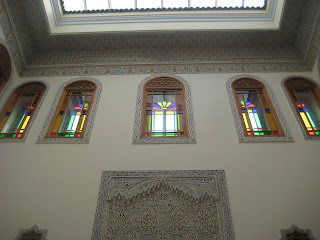
Well to start I think a comparison between Istanbul and Fez is appropriate....they are nothing alike. Istanbul, which used to be the old Roman City of Constantinople, is now a modern tourist adventure. Where as Fez, quite frankly, is a very difficult city to navigate through and has a very, lets use the word 'rustic' feel. Although both cities are of Arabic influence, each city shows it in a very different way.

The culture of Fez was also quite different. Things, I feel, are still done the way that they were done 60 years ago. Although electricity was one of the most defining characteristics of the New World at the turn of the century, in Fez it is still coming around. I don't mean to make it sound uncommon for that it is not, but rather the efficiency that something could be accomplished would show the impact upon the city. And like most Islamic cultures woman wore head scarfs and were often not found outside after dark. But besides the obvious, the city was beautiful and nothing of what I expected. no camels :(
So Fez from the outside, meandering down the streets one would have no idea the difference from one building to the next. There is no demarcation between buildings thus it would be very easy for one to get lost (hence why we followed our excellent tour guides closely). But behind every wall there was a surprise. After gathering information from the reading and then seeing it in person, I was able to fully appreciate the Islamic architectural ideas. This idea that they
 should not spend time on the exterior, but rather focus on the interior spaces. Then they take this idea philosophically and relate it to their lives. For the Islamic culture, from what I understand, is to better oneself and how they live their lives. Not necessarily praying to the God above, but also being at peace with oneself and not feeling the pressure to live in a certain fashion- but to want to live in that fashion. So they try to better themselves emotionally and personally without paying mind to what they look like on the exterior.
should not spend time on the exterior, but rather focus on the interior spaces. Then they take this idea philosophically and relate it to their lives. For the Islamic culture, from what I understand, is to better oneself and how they live their lives. Not necessarily praying to the God above, but also being at peace with oneself and not feeling the pressure to live in a certain fashion- but to want to live in that fashion. So they try to better themselves emotionally and personally without paying mind to what they look like on the exterior.Each inner courtyard is specially decorated to fit with that space. Hand cut tiles, open to the expansive sky above, and beautiful arch ways that lead into annexed spaces these courtyards are what help them to live the lives that they do. Each inner courtyard has its layers of space, created by different edges and walls. And each edge helps to signify something else that means a great deal in their lives. Such as: The edges of the roof tops the frame your view of the sky when looking up from the courtyard. The series of arch ways that lead you possibly into a more
 scared room or into a different sector or meaning of life. The series of entrances from the road to the center of that courtyard. Each of these ideas are established by the underlying ideas of creating an edge from one idea to the next (one architectural space to the next). In their culture one can not just call a courtyard a courtyard without thinking about what the underlying meaning of the direction it is facing, the tile pattern on the wall, and the colonnaded paths ways leading from the center space. Each element has been placed their for a reason, each idea is apart of their actual lifestyle.
scared room or into a different sector or meaning of life. The series of entrances from the road to the center of that courtyard. Each of these ideas are established by the underlying ideas of creating an edge from one idea to the next (one architectural space to the next). In their culture one can not just call a courtyard a courtyard without thinking about what the underlying meaning of the direction it is facing, the tile pattern on the wall, and the colonnaded paths ways leading from the center space. Each element has been placed their for a reason, each idea is apart of their actual lifestyle.So no longer is a wall just a wall that creates an edge that ultimately creates space- it is a lifestyle, a way to perfection. And because of these ideas, I have since become quite interested in learning more about their culture.
Although no camels, Africa was still a success.


No comments:
Post a Comment